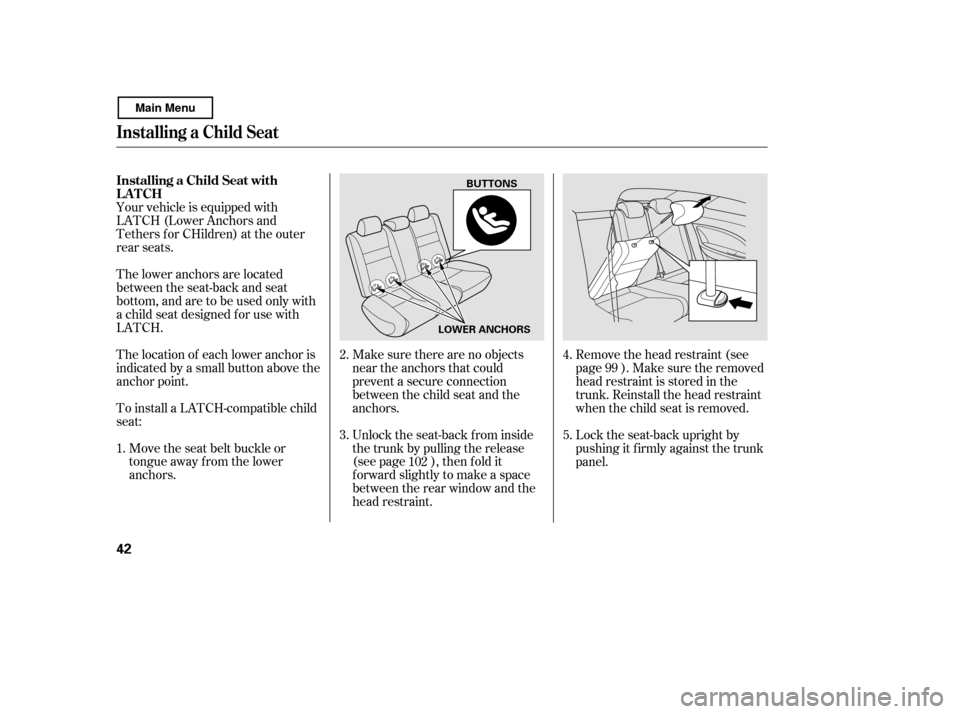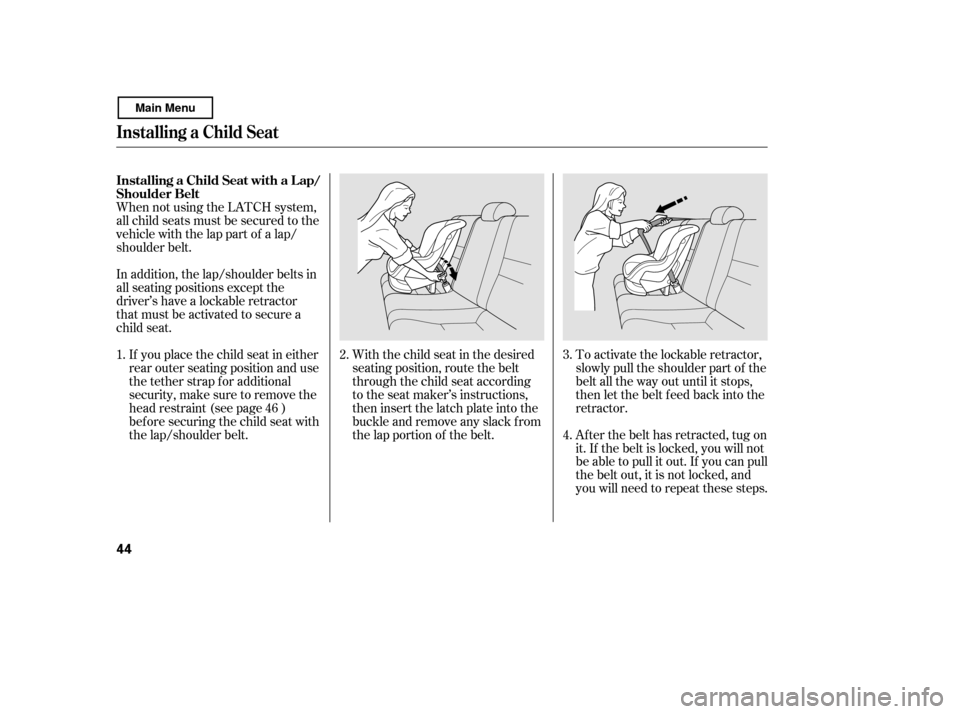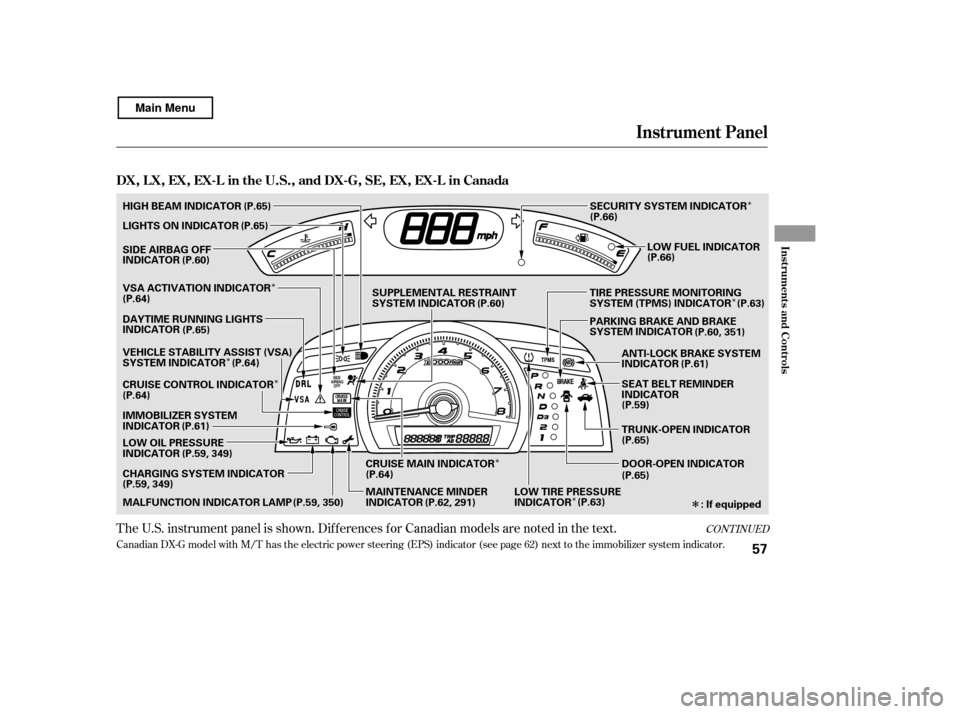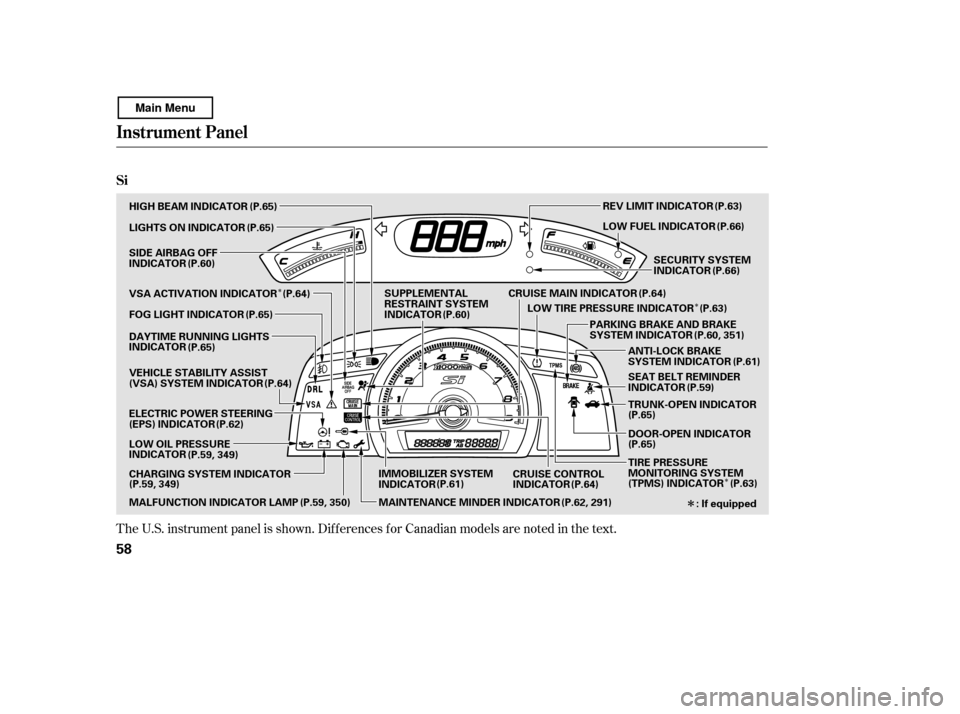Page 46 of 400

Your vehicle is equipped with
LATCH (Lower Anchors and
Tethers for CHildren) at the outer
rear seats.
The location of each lower anchor is
indicated by a small button above the
anchor point.
The lower anchors are located
between the seat-back and seat
bottom, and are to be used only with
a child seat designed f or use with
LATCH.
To install a LATCH-compatible child
seat:
Move the seat belt buckle or
tongue away f rom the lower
anchors. Make sure there are no objects
near the anchors that could
prevent a secure connection
between the child seat and the
anchors.
Unlock the seat-back from inside
the trunk by pulling the release
(see page ), then f old it
f orward slightly to make a space
between the rear window and the
head restraint.Remove the head restraint (see
page ). Make sure the removed
head restraint is stored in the
trunk. Reinstall the head restraint
when the child seat is removed.
Lock the seat-back upright by
pushing it f irmly against the trunk
panel.
1. 2. 3.
4.5.
99
102
Installing a Child Seat with
LATCH
Installing a Child Seat
42
LOWER ANCHORS
BUTTONS
Main Menu
Page 48 of 400

To activate the lockable retractor,
slowly pull the shoulder part of the
belt all the way out until it stops,
then let the belt f eed back into the
retractor.
Af ter the belt has retracted, tug on
it. If the belt is locked, you will not
be able to pull it out. If you can pull
thebeltout,itisnotlocked,and
you will need to repeat these steps.
When not using the LATCH system,
all child seats must be secured to the
vehicle with the lap part of a lap/
shoulder belt.
With the child seat in the desired
seating position, route the belt
through the child seat according
to the seat maker’s instructions,
then insert the latch plate into the
buckle and remove any slack f rom
the lap portion of the belt.
In addition, the lap/shoulder belts in
all seating positions except the
driver’s have a lockable retractor
that must be activated to secure a
child seat.
If you place the child seat in either
rear outer seating position and use
the tether strap for additional
security,makesuretoremovethe
head restraint (see page )
bef ore securing the child seat with
the lap/shoulder belt. 2.
3.
1.
4.
46
Installing a Child Seat with a L ap/
Shoulder Belt
Installing a Child Seat
44
Main Menu
Page 49 of 400
Af ter conf irming that the belt is
locked, grab the shoulder part of
the belt near the buckle, and pull
up to remove any slack from the
lap part of the belt. Remember, if
the lap part of the belt is not tight,
the child seat will not be secure.Push and pull the child seat
f orward and f rom side-to-side to
verif y that it is secure enough to
stay upright during normal driving
maneuvers. If the child seat is not
secure, unlatch the belt, allow it to
retract f ully, then repeat these
steps.
To remove slack, it may help to
putweightonthechildseat,or
push on the back of the seat while
pulling up on the belt. To deactivate the lockable retractor
and remove a child seat, unlatch the
buckle, unroute the seat belt, and let
the belt fully retract.
5. 6.
Installing a Child Seat
Driver and Passenger Saf ety
45
Main Menu
Page 50 of 400
A child seat with a tether can be
installed in any seating position in
the back seat, using one of the
anchorage points shown above.
Since a tether can provide additional
security to the lap/shoulder belt
installation, we recommend using a
tether whenever one is required or
available.Unlock the seat-back from inside
the trunk by pulling the release
(see page ), then f old it
f orward slightly to make a space
between the rear window and the
head restraint.
Remove the head restraint (see
page ). Make sure the removed
head restraint is stored in the
trunk. Reinstall the head restraint
when the child seat is removed.Lock the seat-back upright by
pushing it f irmly against the trunk
panel.
Af ter properly securing the child
seat (see page ), route the
tether strap over the seat-back.
1. 2. 3.
102
99 4.
44
Installing a Child Seat with a
Tether
Using an Out er A nchor
Installing a Child Seat
46
TETHER ANCHORAGE P
OINTS
COVER
ANCHOR
Main Menu
Page 59 of 400

This section gives inf ormation about
the controls and displays that
contribute to the daily operation of
your vehicle. All the essential
controls are within easy reach............................
Control Locations . 56
............................
Instrument Panel . 57
..........
Instrument Panel Indicators . 59
.............................................
Gauges . 67
..............
Display Change Button . 68
.....................................
Odometer . 68
...................................
Trip Meter . 68
Outside Temperature
...................................
Indicator . 69
..................................
Fuel Gauge . 70
...................
Temperature Gauge . 70
..........
Check Fuel Cap Message . 70
...............
Maintenance Minder . 71
Controls Near the Steering
...........................................
Wheel . 72
.
Windshield Wipers and Washers . 73
.........
Turn Signals and Headlights . 74
........................................
Fog Lights . 75
........
Instrument Panel Brightness . 76
.................
Hazard Warning Button . 77
.................
Rear Window Def ogger . 77
........
Steering Wheel Adjustments . 78
...............................
Keys and Locks . 79
........................
Immobilizer System . 80
................................
Ignition Switch . 81 ......................................
Door Locks . 82
......................
Power Door Locks . 83
.
Auto Door Locking/Unlocking . 84
.......................
Remote Transmitter . 89
................................................
Trunk . 93
........
Emergency Trunk Opener . 94
.................................................
Seats . 95
..................................
Seat Heaters . 103
............................
Power Windows . 104
.......................................
Moonroof . 106
...........................................
Mirrors . 108
...............................
Parking Brake . 109
.........
Interior Convenience Items . 110
.....................
Beverage Holders . 111
.............
Console Compartment . 111
..................................
Glove Box . 111
..................................
Coat Hook . 112
........
Accessory Power Sockets . 112
............................
Vanity Mirror . 113
...................................
Sun Visor . 114
...............................
Interior Lights . 114
..............................
Ceiling Light . 114
...................................
Spotlights . 115
..........................
Courtesy Light . 116
Instruments and Controls
Inst rument s and Cont rols
55
TM
Main Menu
Page 60 of 400
�Î
�Î
�Î
�Î
�Î�Î �Î�Î
�Î
�Î
If equipped
:
Control L ocations
56
HEATING/COOLING
CONTROLS
(P.118)
A/T model without navigation system is shown. INSTRUMENT PANEL INDICATORS
MOONROOF SWITCH
HAZARD WARNING BUTTON (P.77) (P.106)
(P.57, 58)
GAUGES
(P.67)
MIRROR CONTROLS
(P.108)
POWER DOOR LOCK
MASTER SWITCH
(P.83)
POWER WINDOW
SWITCHES
(P.104)
(P.144, 153, 196, 207)
SEAT HEATER SWITCHES
(P.103) USB ADAPTER CABLE ACCESSORY POWER
SOCKETS
AUDIO SYSTEM
CLOCK
(P.222)
(P.123)
(P.112)
FUEL FILL DOOR/
TRUNK RELEASE HANDLE
(P.253, 93)
HOOD RELEASE
HANDLE
(P.254)
Main Menu
Page 61 of 400

�Î�Î
�Î
�Î
�Î �Î �Î
�Î
CONT INUED
Canadian DX-G model with M/T has the electric power steering (EPS) indicator (see page 62 ) next to the immobilizer system indicator.
The U.S. instrument panel is shown. Dif f erences f or Canadian models are noted in the text.
Instrument Panel
Inst rument s and Cont rols
DX,LX,EX,EX-L intheU.S.,andDX-G,SE,EX,EX-L inCanada
57
(P.64)
: If equipped
SECURITY SYSTEM INDICATOR
(P.66)
LOW FUEL INDICATOR(P.66)
(P.64)
(P.59, 350)
(P.59, 349)
LOW OIL PRESSURE
INDICATOR (P.61)(P.64)
MAINTENANCE MINDER
INDICATORSUPPLEMENTAL RESTRAINT
SYSTEM INDICATOR
CRUISE MAIN INDICATOR
(P.65)
(P.65)
HIGH BEAM INDICATOR
LIGHTS ON INDICATOR
SIDE AIRBAG OFF
INDICATOR
DAYTIME RUNNING LIGHTS
INDICATOR
VSA ACTIVATION INDICATOR
VEHICLE STABILITY ASSIST (VSA)
SYSTEM INDICATOR
IMMOBILIZER SYSTEM
INDICATOR
CHARGING SYSTEM INDICATOR
(P.59, 349)
MALFUNCTION INDICATOR LAMP ANTI-LOCK BRAKE SYSTEM
INDICATOR
SEAT BELT REMINDER
INDICATOR
TRUNK-OPEN INDICATOR
(P.65)
DOOR-OPEN INDICATOR
(P.65)
(P.60)
(P.64) (P.65) (P.60)
PARKING BRAKE AND BRAKE
SYSTEM INDICATOR
(P.61)
(P.59)
(P.62, 291)
CRUISE CONTROL INDICATOR
(P.60, 351)
(P.63)
TIRE PRESSURE MONITORING
SYSTEM (TPMS) INDICATOR
LOW TIRE PRESSURE
INDICATOR (P.63)
Main Menu
Page 62 of 400

�Î�Î
�Î
�Î
The U.S. instrument panel is shown. Dif f erences f or Canadian models are noted in the text.
Instrument Panel
Si
58
DOOR-OPEN INDICATOR
SEAT BELT REMINDER
INDICATOR
(P.59, 350) LOW FUEL INDICATOR (P.66)
SECURITY SYSTEM
INDICATOR (P.66)
CRUISE MAIN INDICATOR (P.64)
PARKING BRAKE AND BRAKE
SYSTEM INDICATOR
(P.65)
SUPPLEMENTAL
RESTRAINT SYSTEM
INDICATOR (P.60)
(P.60)
(P.64)
HIGH BEAM INDICATOR
LIGHTS ON INDICATOR
SIDE AIRBAG OFF
INDICATOR
VSA ACTIVATION INDICATOR
FOG LIGHT INDICATOR
DAYTIME RUNNING LIGHTS
INDICATOR
ELECTRIC POWER STEERING
(EPS) INDICATOR
LOW OIL PRESSURE
INDICATOR
CHARGING SYSTEM INDICATOR
(P.59, 349)
MALFUNCTION INDICATOR LAMP (P.65)
(P.65)
(P.65)
(P.64)
(P.62)
(P.59, 349) CRUISE CONTROL
INDICATOR
(P.61)
MAINTENANCE MINDER INDICATOR
IMMOBILIZER SYSTEM
INDICATOR
(P.62, 291)(P.64) (P.65)
TRUNK-OPEN INDICATOR
(P.65)
(P.59)
VEHICLE STABILITY ASSIST
(VSA) SYSTEM INDICATOR (P.60, 351)
REV LIMIT INDICATOR (P.63)
ANTI-LOCK BRAKE
SYSTEM INDICATOR (P.61)
LOW TIRE PRESSURE INDICATOR (P.63)
TIRE PRESSURE
MONITORING SYSTEM
(TPMS) INDICATOR (P.63)If equipped
:
Main Menu